Community Window on Environmental Exposures

[ad_1]
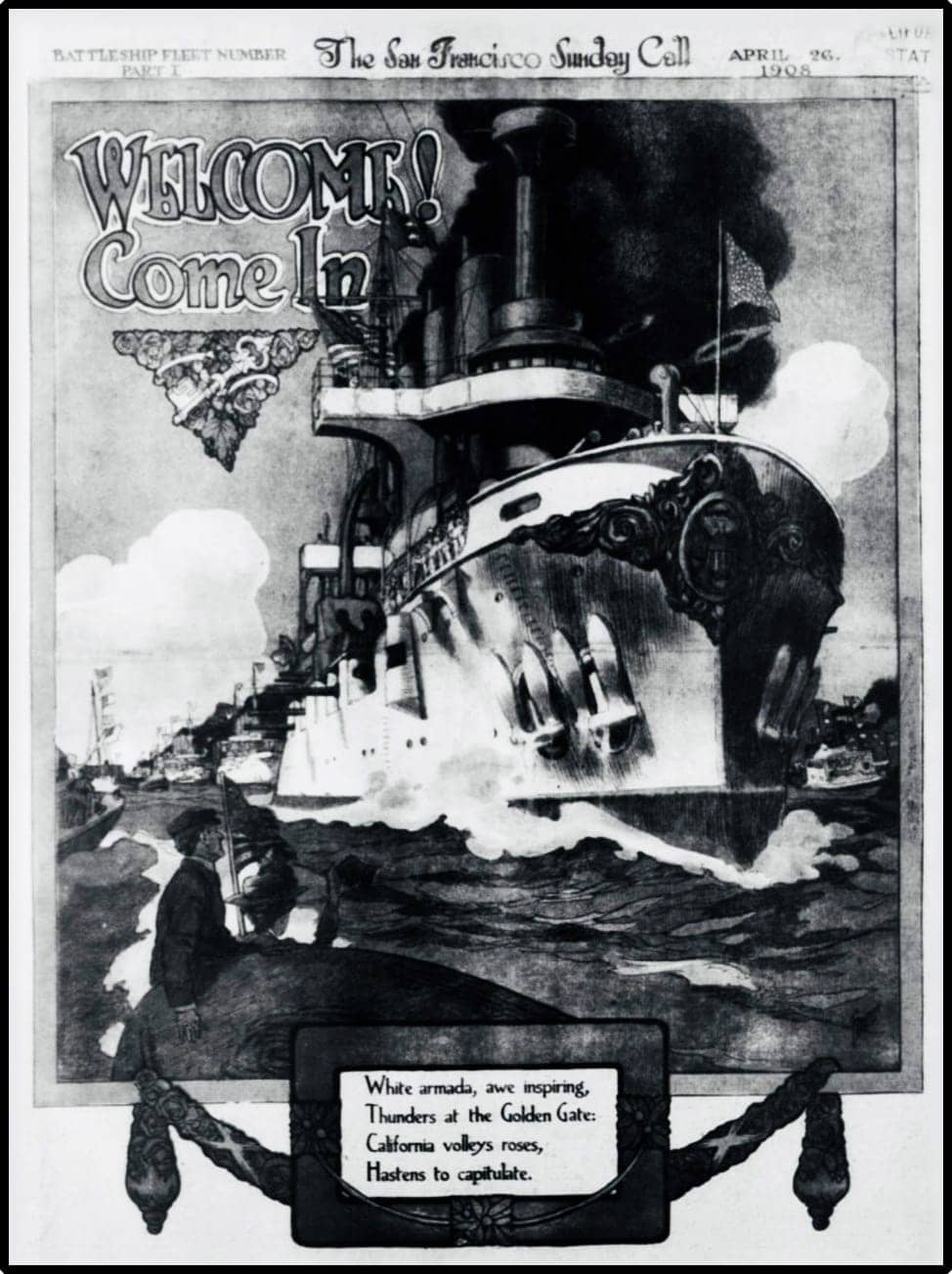
by Ahimsa Porter Sumchai MD
The greatest story never told!
“Roosevelt’s idea was to show that the United States was a power to be reckoned with.” – Professor of History Richard Abrams, UC Berkeley
“Speak softly and carry a big stick” is the African motto that embodied the foreign diplomacy of President Theodore Roosevelt, whose “Great White Fleet” traversed San Francisco Bay on May 6, 1908, en route to “The World’s Greatest Shipping Yard” at Hunters Point.
Newspapers called it “the grandest spectacle of the age,” as Roosevelt’s Atlantic Fleet of 16 gold gilded battleships steamed through the Golden Gate en route to the Hunters Point Dry Docks.
Following two months of respite, recovery, maintenance and refueling, the Great White Fleet departed Hunters Point on a 14-month tour de force around the world. A historic archive of photo, cartoon and media reports chronicle the magnificence of the spectacle witnessed by over a million people who gathered to view the flotilla enter San Francisco Bay.
In memorializing Asian Pacific Heritage, let us remember Roosevelt’s use of “big stick diplomacy” to denounce efforts by the Board of Education to segregate Asian students and the mayor’s racist attempts to block the influx of Japanese immigrants.
The coastal wetlands and ancient hills of the promontory extending eastward into a once pristine San Francisco Bay were cultivated by the Ramaytush Ohlone for 4,000 years before the arrival and colonization by Spanish explorers in the 1700s.
Surrounded on three sides by the Bay, the Ohlone navigated the promontory by canoe. In 1816 Louis Choris created an artistic depiction of the Ohlone in a canoe constructed of tule reeds harvested from the coastal marshes of San Francisco Bay.
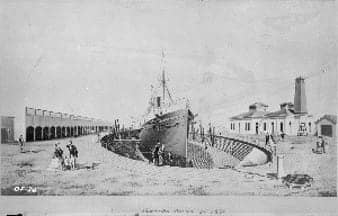
California historian Helen Marcia Bruner wrote the essay titled “The Story of Hunters Point” in the September 1953 National League. The first Pacific Coast dry dock was constructed in 1867 after New York real estate investors and brothers Phillip Schuyler Hunter, Robert Eugene Hunter and John Hunter gained the deed of title to a portion of a 4,000-acre land grant awarded to Jose’ Cornelio Bernal during the California Gold Rush in 1849.
Named “Kali Forno” by Native Americans and “Califas” by Spanish colonizers, California joined the Union as a free state in 1850 with a Constitution that expressly prohibited slavery.
On July 28, 1849, the Hunter brothers arrived in San Francisco on the Clipper Memnon. The family built a mansion and dairy farm on Griffith and Oakdale Avenue in modern day Hunters Point – on the site of what is now public housing!
The arsenal of America
“December 1941: A sudden attack on a distant US naval base transformed America overnight into the ‘home front.’ Everything changed, especially the swelling industrial workforce. It included millions … in particular African American women embodied by ‘Rosie the Riveter.’” – American Rosie the Riveter Association, honoring our country’s Black Rosies
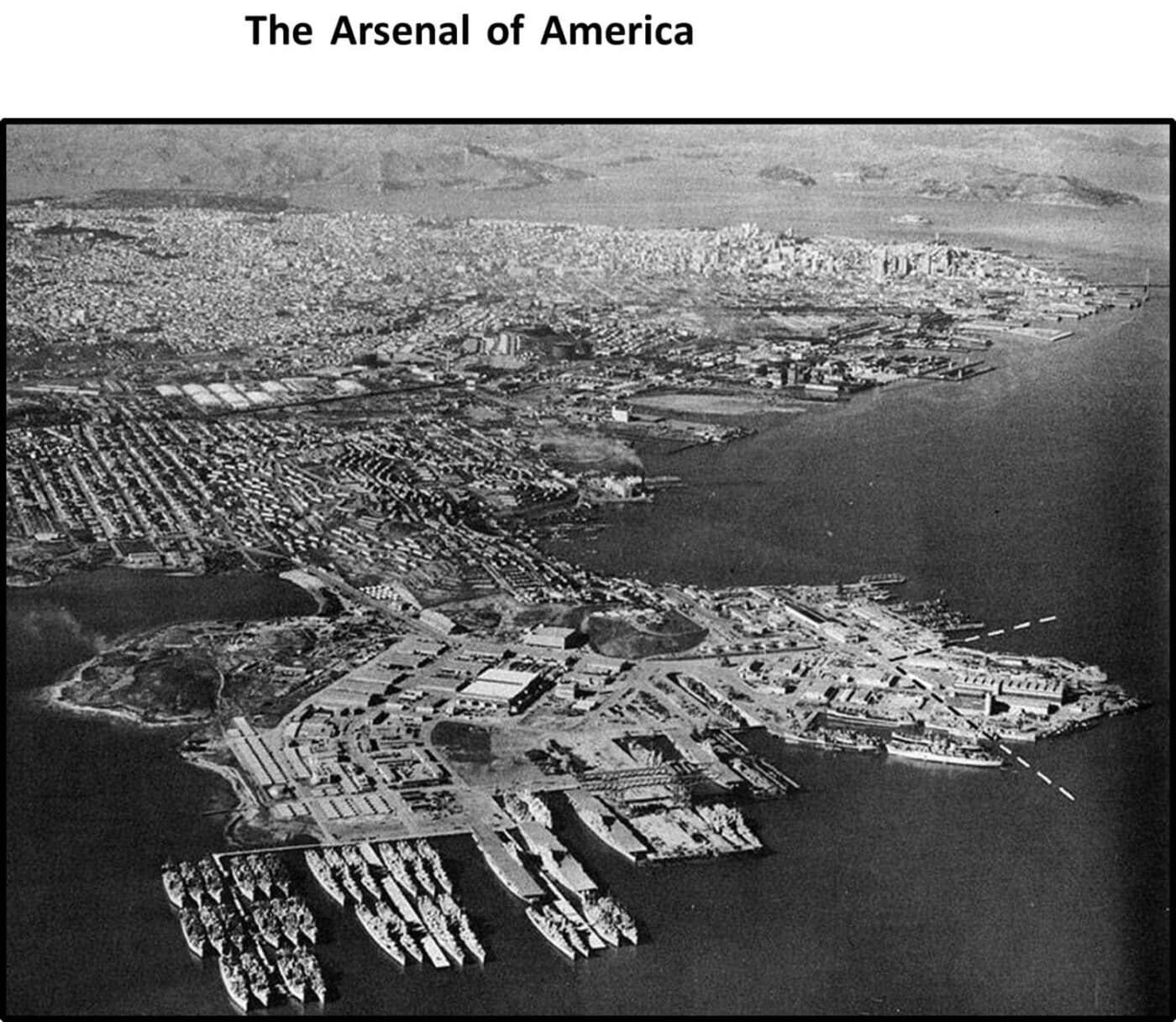
An estimated 6 million women entered the US workforce during the war. The government initially recruited single white women but minority women, who had always worked, became half of the defense workforce. By 1944, women comprised half of the workforce in roles that included clerical and administration, bus drivers and lab technicians.
The West Coast became the epicenter of wartime shipbuilding. The San Francisco Bay Area alone launched 45% of wartime cargo. The Hunters Point Naval Shipyard operated as a repair facility from 1945 until 1974.

The United States Naval Radiological Defense Laboratories operated in a campus along the southern shoreline from 1948 to 1969. NRDL experimented with 108 radioisotopes and listed 33 as radionuclides of concern in the Historical Radiological Assessment.
In 1974 the Navy ceased shipyard operations and from May 1976 to June 1986 the Navy leased the base to Triple A Machine Shop, Inc. Dry Docks 2 through 7 operated at the Hunters Point Naval Shipyard until its disestablishment in 1989 and closure under the Base Realignment and Closure Act in 1991.
“While moored at San Francisco’s Hunters Point Naval Shipyard, Independence was the primary focus of the Navy’s studies on decontamination until age and the possibility of its sinking led the Navy to tow the blast damaged carrier to sea for scuttling on January 26, 1951.” – Todd Lappin
The bomb-scarred radioactive hulk of the World War II aircraft carrier USS Independence was docked along the historic Gun Mole Pier beneath the towering Gantry Crane at the Hunters Point Naval Shipyard. It operated as a floating radiation laboratory from 1948 to 1951.
Exposed to the detonation of two 21 kiloton Fat Man plutonium bombs, the Independence was part of a fleet of target ships hauled back to Hunters Point following Operation Crossroads nuclear weapons testing in the South Pacific in July 1946.
According to the shipyard’s Historical Radiological Assessment, the Navy burned over 600,000 gallons of nuclear fuel oil in power plants on the base over a neighborhood with an estimated 30,000 people. That fuel contained plutonium!
‘We can’t do anything about this!’
A woman – we’ll identify her as KT – lives within feet of the unreinforced fence line of a Federal Superfund Site landfill and shoreline. She is a veterinary technician disabled by work injuries. Additionally, five expert doctors verify her to have signs, symptoms, risk factors, toxic screens, lab findings and health effects caused by exposure to radioactive heavy metals at the Hunters Point Naval Shipyard.
KT lives about 100 feet away from the shipyard’s most heavily contaminated regions, the Parcel E-2 industrial landfill and the radiation contaminated western panhandle region. She returned from Mexico in May from a trip she financed to undergo chelation therapy hoping it would leach her body of radioactive chemicals she is exposed to that are documented to be present in shipyard landfills, soils, sediment, groundwater, air and radiation laboratories.
KT has lived for over a decade half a block west of Fitch Street, the western boundary between the densely populated south central Hunters Point neighborhood and the Shipyard’s Parcel E-2 industrial landfill and radiation contaminated panhandle region.
A former vet technician who has witnessed the cancer deaths of many companion animals, KT reports seeing dead raccoons.
An unfortified chain metal fence separates south central Hunters Point from deep soil excavations and heavy equipment operations actively conducted by Navy contractors along the shipyard’s western fence line.
Photos taken by KT show heavy vehicle operations and deep soil excavations conducted by the Navy and its contractors within 100 feet of the Fitch Street chain metal fence that spans the radiation contaminated western panhandle region.
The shipyard’s panhandle region may pose a greater risk of radiation exposure to nearby “sensitive receptors” than the Parcel E-2 Industrial landfill due to its proximity to residents, schools, churches, playgrounds, businesses and nonprofit community based organizations located within the half mile perimeter at Third Street coursing south along Quesada, Revere, Shafter, Thomas, Underwood, Van Dyke and Williams – all the way south to the north shore of Yosemite Slough.
A frequently referenced graphic map created by the NBC Investigative Team highlights radiologically impacted Shipyard regions in pink. Regions designated “hot pink” are heavily contaminated, most notably the western panhandle. The Navy deposited radioactive metal slag in the metal reef area adjacent to where thousands of people ”live, work, play and pray”!
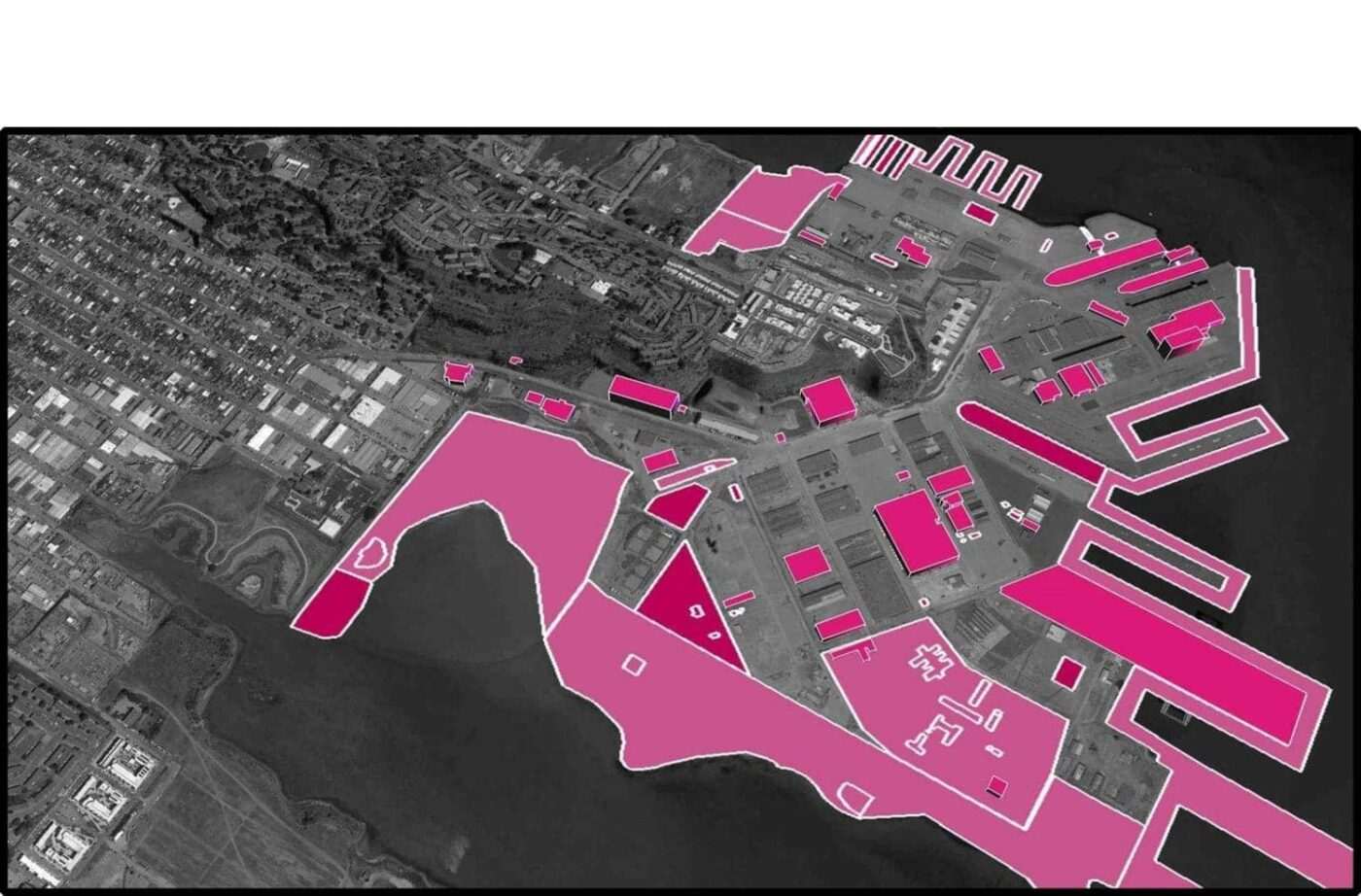
According to the EPA EJScreen, approximately 23,000 people live within the one mile perimeter of an indicator pin placed at the Crisp Road corridor of entry.
Hunters Point Naval Shipyard Parcel F shoreline boundary map documents the metal reef and experimental shielding range located in the western panhandle region of the base to be radiologically impacted. The panhandle region is adjacent to a dense “nest” of sensitive receptors in south central Hunters Point.
In 2016 the EPA designated Yosemite Slough a federal Superfund Site. It is a horizontal channel that extends west into the densely populated region a quarter of a mile away from the neighborhood transit corridor, Southeast Health Center, MLK swimming pool, Bayview KC Jones playground and a “nest” of private homes, public housing, restaurants and food service industries, nonprofits and community based service providers and businesses operating along the Third Street corridor.
“The Navy disputes that the site harms the health of area residents. Doctors who launched an effort to test families for exposure disagree.” – “City Planners Targeted a Black Community for Heavy Pollution” by Darryl Fears and John Muyskens, Washington Post, May 7, 2023
Following the advice of Hunters Point Biomonitoring doctors, KT went to San Francisco General Hospital in 2022 seeking supportive care and expert toxicology consultation. She brought with her the urinary screening that detected 20 dangerous chemicals in toxic concentrations and reports being told at the reception desk, “We can’t do anything about this!”
KT was next referred to an environmental medicine expert and underwent blood lead testing that came back elevated. She reports being told it could not be treated because “she would continue to be exposed to lead where she lives.”
In July of 2022, she underwent a 24-hour urinary screening capable of detecting radioisotopes of uranium, plutonium and potassium. The test was conducted by an environmental toxicologist and founder of a biomonitoring laboratory.
Radioactive potassium K-40 was detected using gamma spectroscopy in concentrations of 3.92 pCi/g, eight times the allowable limit of 0.47 pCi/g! Isotopic plutonium by alpha spectroscopy detected Pu-238 and Pu-244 in concentrations exceeding allowable limits.
Uranium 233/234, 235/236, 238 and total uranium were all detected in concentrations exceeding upper limits. Total uranium was detected in concentrations of 0.058 pCi/g, four times higher than the 0.014 pCi/g allowable limit.
KT underwent repeat urinary screening in May of 2023 following her trip to Mexico for chelation therapy. It documents overall declines in lead, barium, cadmium, cesium, copper and manganese but persistently high levels of rubidium, tungsten, uranium and molybdenum when compared to an interval screening conducted in September of 2022.
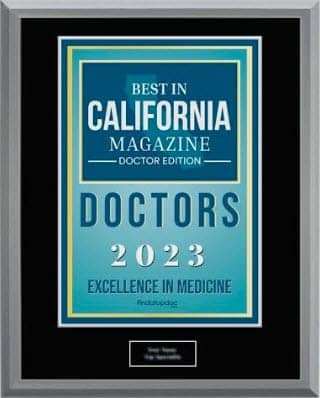
Respecting community narratives of environmental injustice
“Communities that bear the brunt of environmental pollution and lack basic amenities have a story to tell. One such community is the Bayview Hunters Point community in San Francisco, California. There, the US Navy extensively contaminated a now-shuttered shipyard with nuclear waste.” – Professor Helen Kang
Helen Kang is a professor of law and director of the Environmental Law and Justice Clinic at Golden Gate University. Founded in 1994 to provide legal support to communities burdened by pollution, she writes in “Respect for Community Narratives of Environmental Justice” of the dignity and right to be heard and believed – and government’s duty to be accountable.
In a scholarly review, Kang tells the story of the Hunters Point Naval Shipyard as an “egregious example of injustice.” “That would be so even if based solely on the radioactive characteristics of the contamination, which raises special alarm bells because of the slow decay and harms associated with radioactivity.
“But the historical context of the neighborhood also makes this predicament unjust: The composition of the shipyard neighborhood was predominantly Black because of government forced segregation …. Even beyond this invidious distinction, the shipyard story is emblematic of a larger problem. These environmental injustice stories illustrate a confluence of systemic failures, one of which is the failure of various actors in the legal and administrative system to respect community voices.”
In 2020 Kang was honored as 2020 recipient of the Svetlana Kravchenko Environmental Award. In an article published in Bloomberg Law, Kang writes “How 93 US Attorney’s Offices Can Enforce Environmental Justice” in response to the May 5, 2022, comprehensive environmental justice enforcement strategy that was issued by the U.S. Department of Justice informed by community input.
Community Window on Environmental Exposures is supported by CalEPA EJ Small Grant #G21-EJ-030 and the Environmental Justice Data Fund/Windward Fund Award 2022 in collaborative partnership with the San Francisco Bay View newspaper, the Marie Harrison Community Foundation and James Dahlgren Medical.
SF Bay View Health and Environmental Science Editor Ahimsa Porter Sumchai, MD, PD, founder and principal investigator for the Hunters Point Community Biomonitoring Program, founding chair of the Hunters Point Naval Shipyard Restoration Advisory Board’s Radiological Subcommittee and contributor to the 2005 Draft Historical Radiological Assessment, can be reached at AhimsaPorterSumchaiMD@Comcast.net. Dr. Sumchai is medical director of Golden State MD Health & Wellness, a UCSF and Stanford trained author and researcher, and a member of the UCSF Medical Alumni Association Board of Directors.
[ad_2]
Source link

